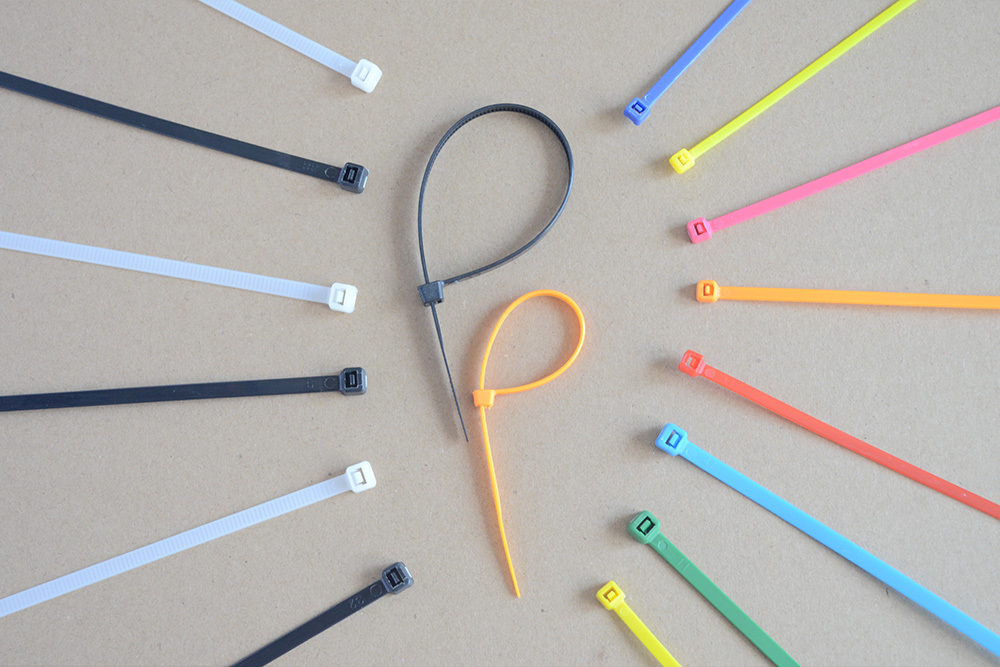22
2025
-
07
Common problems with plastic cable ties
Author:
Common Issues with Plastic Cable Ties and Practical Solutions
Plastic cable ties, while versatile and cost-effective, are prone to specific issues depending on material quality, environmental conditions, and usage patterns. Understanding these challenges and their root causes can help users select appropriate products and extend their service life.
Material-Related Failures
Low Tensile Strength and Brittleness
Many low-quality cable ties are manufactured using recycled nylon or inferior polymer blends, which significantly reduce their tensile strength. For instance, ties made from recycled materials may exhibit brittleness when exposed to temperatures below -20°C, leading to sudden fractures during installation or use. This is particularly problematic in outdoor applications, such as securing solar panel cables in cold climates, where ties must withstand both mechanical stress and thermal cycling.
Poor Locking Mechanism Design
Traditional single-tooth locking structures are prone to loosening under vibration or repeated stress. In industrial settings, such as automotive assembly lines or data centers, ties with inadequate locking mechanisms may gradually slip, causing cable bundles to become disorganized or equipment to malfunction. Advanced designs, such as multi-tooth or metal-reinforced locking systems, mitigate this issue by distributing stress more evenly across the locking surface.
Environmental Degradation
UV and Weathering Damage
Standard nylon cable ties degrade rapidly when exposed to prolonged sunlight, especially in regions with high UV radiation levels. Over time, UV rays break down polymer chains, causing surface cracking, discoloration, and loss of mechanical properties. In coastal areas, salt spray accelerates corrosion, further weakening the material. Specialized UV-stabilized ties, which incorporate additives to absorb or reflect harmful rays, can extend outdoor lifespan by up to three times compared to standard variants.
Hydrolysis in Humid Conditions
Nylon’s hygroscopic nature means it absorbs moisture from the air, which can enhance flexibility but also lead to hydrolysis—a chemical reaction that breaks down polymer chains. In humid environments, such as tropical regions or industrial facilities with high humidity, ties may become brittle or lose tensile strength over time. To counter this, users should store ties in sealed containers with desiccants and avoid prolonged exposure to damp conditions.
Thermal Instability
Most standard nylon ties are rated for temperatures between -40°C and 85°C, but extreme heat or cold can cause rapid degradation. In automotive engine compartments or near heat-generating machinery, ties may soften, deform, or melt, compromising their ability to secure cables. Conversely, in freezing temperatures, ties can become brittle and snap under minimal stress. High-temperature-resistant variants, such as those made from polyphenylene sulfide (PPS) or polyimide, are better suited for such environments.
Installation and Usage Errors
Over-Tightening and Mechanical Stress
Applying excessive force during installation can create stress concentrations, leading to premature failure. For example, over-tightened ties around irregularly shaped objects may develop cracks at the bending points. Using calibrated tensioning tools ensures optimal tightness without damaging the tie or the secured item. Additionally, selecting ties with adjustable tension settings can help prevent over-tightening in sensitive applications.
Incorrect Storage Practices
Improper storage conditions, such as exposure to direct sunlight, high temperatures, or moisture, can accelerate degradation before the ties are even used. For instance, ties stored in metal sheds during summer may absorb heat, reaching temperatures that exceed their operational limits and causing irreversible damage. Storing ties in cool, dark, and dry environments, ideally in sealed containers, helps maintain their integrity until use.
Reusability Limitations
While most cable ties are designed for single-use, some scenarios demand reusability. However, repeatedly opening and closing standard ties can damage the locking mechanism, reducing their effectiveness. For applications requiring frequent adjustments, such as temporary event setups or prototyping, reusable ties with quick-release features or adjustable lengths are more practical.
Addressing Seasonal and Regional Challenges
Winter Brittleness
In cold climates, nylon ties often become brittle due to low humidity and reduced molecular mobility. This issue can be mitigated by pre-conditioning ties before use—for example, by storing them in a heated warehouse or injecting a small amount of purified water into their packaging to restore flexibility. Alternatively, using ties formulated with anti-static additives can reduce brittleness in dry conditions.
Coastal and Marine Corrosion
In saltwater environments, standard nylon ties are vulnerable to corrosion, which weakens the material and shortens lifespan. For marine applications, such as securing buoys or underwater cables, ties made from corrosion-resistant materials like 316 stainless steel or PPS are more durable. These variants can withstand prolonged exposure to saltwater without significant degradation.
By addressing these common issues through proper material selection, environmental management, and installation techniques, users can maximize the reliability and longevity of plastic cable ties across diverse applications.
plastic cable ties
Hot News
2025-07-22
Introduction to the insulation properties of plastic cable ties
Plastic cable ties, commonly known as nylon zip ties, are widely used across industries due to their versatility, cost-effectiveness, and reliable insulating properties. These properties make them indispensable in electrical, electronic, and mechanical applications where safety and performance are critical.
2025-07-22
Common problems with plastic cable ties
Plastic cable ties, while versatile and cost-effective, are prone to specific issues depending on material quality, environmental conditions, and usage patterns. Understanding these challenges and their root causes can help users select appropriate products and extend their service life.
2025-07-21
Introduction to the service life of plastic cable ties
Plastic cable ties, also known as zip ties or nylon ties, are indispensable tools across industries due to their simplicity, cost-effectiveness, and versatility. However, their service life varies significantly depending on material composition, environmental conditions, and usage scenarios.
2025-07-21
Plastic cable ties are arranged in a straight line for binding
Plastic cable ties are ideal for securing items in a straight, parallel arrangement, ensuring neatness and structural integrity. This method is commonly used for bundling cables, organizing tools, or fastening materials in rows. Below are detailed steps to achieve professional straight-line绑扎 (binding) results.

